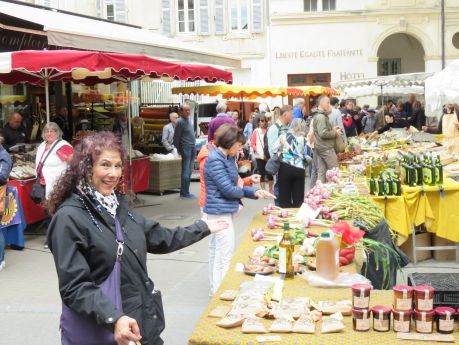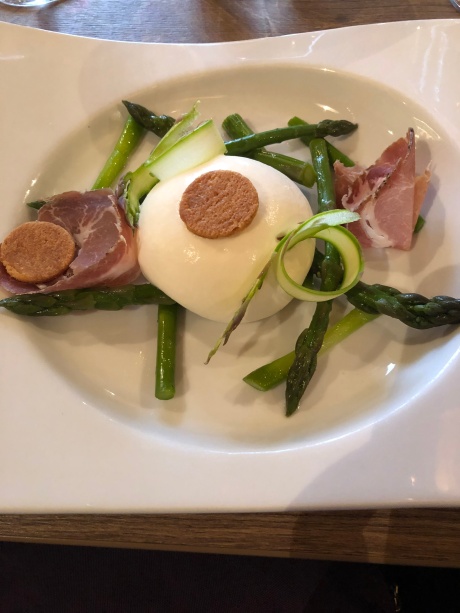Part 4: SOUTHERN FRENCH CONNECTION: ART, FOOD & WINE
In Part 3, we cruised down the Canal du Midi in a barge, cooked a full-course meal in a 5-star French hotel’s cooking school, and learned that Vincent Van Gogh left his impressions on more than canvas.
SAINT-REMY-DE-PROVENCE, LES-BAUX-DE-PROVENCE, ISLE-SUR-LA-SORGUE and ROUSSILLON
One of the absolute delights of this Southern France trip was getting to visit (albeit too briefly) small mountainside medieval villages on day excursions. We were lodging in Aix-en-Provence. Each village brimmed with the flavors of France, from fresh bags of lavender to nutty confections of nougat, to the flower-potted window sills that crowded narrow passageways within the former fortress rock walls. The air was fresh from mountain breezes. The views of multi-hued fieldsin the valleys below, the gentle warmth of country residents, and local wines were the essence of a pastoral existence far removed from the bustle of metropolises like Paris.
Where we stayed:
For the remainder of our two-week tour and the three days of extension, Aix-en-Provence proved to be a good base from which to travel on day trips. We stayed at Grand Hotel Roi Rene, a 134-room property in the heart of the city’s historic old town. This hotel was a disappointment, even though well located and modern. There was nothing French in décor or architecture. The plain room was bland in browns and beiges. As was typical on this particular tour’s hotels, the toilet was separated from the shower, though it was also our first room with the shower in the tub. There was no bar soap, only liquid in large containers. With my allergies and unable to read ingredients, I was happy I had brought my own backup toiletries. This was not a bathroom designed by women. Though there were shelves underneath the sink, they were deep and set back so you’d have to do a deep knee bend to see your personal products. We finally found three accessible wall plugs, but only after pulling out all the furniture in the room. Two were behind end tables and one was behind a desk. The buffet breakfast was the most diverse of any of the other hotels on this trip, but the wait staff appeared untrained and unable to cope with handling tour groups on short time schedules.
Saint-Remy-de-Provence
We lucked out being in Saint-Remy-de-Provence on Market Day, an every-Wednesday occurrence. Sellers hawk fast foods ready to be eaten immediately, from deli sandwiches to French fries. Aromatic herbs and olives in varying shades of blacks, greens and purples inhabit large wooden crates propped like art work on rectangular tables. Rounds of nougat as big as professional-sized frisbees in colors of white, red, or green, were flavored with lavender, pistachio, caramel, raspberry etc, vying for attention from redolent loaves of breads and pastries fresh from ovens that morning. Local merchants vended clothes, shoes, jewelry, and scarves from the softest silk to the warmest wool. The market winds around the crowded streets of the charming village. Villagers scurry to buy before the 2 pm closing. I bought gifts for friends and family, nougat and glazed nuts for Russ and me, and a neon purse in primary colors that drew me in like a powerful magnet. To my surprise when I later examined the tags tucked inside a pocket, the purse I bought in France was made in Italy.
We left the market and headed to Saint-Paul Asylum, now called the Clinique Van Gogh, because this is where he committed himself to a year of sanitarium care in 1889. As you walk to the now-museum and gift shop, replicas of Van Gogh paintings of area landscapes line the path. You can read a copy of Van Gogh’s last letter to his brother Theo, stressing that he thinks his stay here is good for him. The tiny, spare room with one window and not much more than a cot-sized bed and a water bowl on top of a dresser are preserved forevermore. To the right of the bed his painting of the room is propped on an easel. Paintings of his surroundings in impressionistic swirls of paint left me feeling his sadness, confusion and emptiness. His prophecy that people wouldn’t appreciate his art until 30-40 years after his death was unfortunately true. There’s one thing you should know about this venue. There is only one public restroom and it’s outside by the gardens. If multiple tourist buses are present, that line moves very, very slowly. Have a Wet Wipe and tissues handy.
Les-Baux-de-Provence
Considered one of the most beautiful villages in France, Les-Baux-de-Provence didn’t have a market when we visited, but we did scale the two (only) cobbled streets that wound around like a spiral staircase to the top of the former castle fortress’ mountaintop. Heavily populated in the 11th century in the heart of the Alpilles regional country park, the castle ruins lay unnoticed until tourists rediscovered them in the 1960s. Small shops are nestled snugly into the castle’s rock walls. Cafes with maybe four outside tables jut out over the street below. Despite its size, Les Baux draws thousands of tourists each year for its midnight mass holiday nativity scene. We learned that bauxite ore was named after this city once the quarry’s supply was depleted.
Too late, and with no time to spare, we also discovered that the immersive art show, Carrieres de Lumieres, was being held in Paris and Les Baux. This time it featured the works of Vincent Van Gogh. Mountain time travel would have taken us an hour-and-a-half to reach the abandoned quarry where the show is annually held each year (featuring different artists) and reservations sell out months in advance of the showings. The best time to visit Les-Baux-de-Provence is March through November to avoid the fierce winter mistral winds.
Isle-sur-la-Sorgue
Isle-sur-la-Sorgue is known as the “Venice of Provence” for its canals and pedestrian bridges that span the Sorgue River. We saw window displays of the town’s signature glazed fruits and a 17th century church named La Collegiale Notre Dame des Anges (Our Lady of Angels). Originally built in Gothic design and later rebuilt in Baroque style, there are 220 sculpted angels inside, each holding representations of various virtues. The exterior is quite plain, but the interior is quite adorned.
This was yet another quaint town, and yet another farmer market that we wished we could have perused at a more leisurely pace. Russ satisfied his then-daily ice cream fix while I scanned booths hoping to find olive wood containers filled with fresh Herbs de Provence that I’d seen at Saint-Remy. Success was achieved at one of the last booths we passed from two very-kind gentlemen who took the time to show me how to operate, refill and season the wood.
We then ate a quick, light meal at Grand Café. Russ enjoyed his first Croque Monsieur (basically a ham-and-cheese filled sandwich with more cheese on the outside, then fried). The sandwich slid down easily with local white wine.
ROUSSILLON
En route to Roussillon, yet another village designated as one of France’s most beautiful, we passed by the small landlocked mountainside village of Gordes. We stopped long enough on the roadside to snap a few photos of this expensive village that caters to journalists, actors and other celebrities. The houses appeared stacked upon one another, ascending the mountain. The views must be worth the inconvenience of living in a place where a parking lot accommodates residents’ cars. The walk from there to houses looked steep. Not something I’d want to do with a bundle of groceries.
We continued on to Roussillon, passing through fields resplendent in bright red and yellow flowers called gor, past button mushroom-shaped bushes that will morph into gorgeous lavender by mid-June, deep red clay soil that contrasts starkly against green grasses, and into the village bedecked with barrel red-tile roofs. Our Tour Director Fanny Poirier said Playwright Samuel Beckett hid in Roussillon from the Germans during 1942-1945 and that one of the characters in his famous Waiting For Godot alludes to the town.
Our final stop for the day was at Domain Terre de Mistral, just one of many hands-on experiences we receive travelling with Odysseys Unlimited. We’ve made strudel on a farm in Budapest, Hungary and a four-course meal on this trip at La Miranda in Avignon. We’ve tasted wine and olive oil on a farm in Spain and on this trip, we visit a 10-year-old winery originally created by two families that sits between the Montagne Ste Victoire and Ste Baume range. Domain Terre de Mistral has more than 3,000 olive trees on about 54 acres and more than 145,000 acres for vineyards. They produce 50% of what they serve in their onsite restaurant.
Our olive oil and wine tasting experience began with a guided tour of the vineyards. We saw the steel vats fermenting wine and heard about their process. Our knowledgeable French winery guides told us that Domain Terre de Mistral is known for rose wines, that the winery is ecofriendly but not organic, and that they use both oak and acacia barrels. The wines are named after the winery owner’s family members, so a pretty perfume bottle-shaped wine is called Pauline, named for his daughter. The barrels are used a maximum of three times, but it is acknowledged that the second usage provides the best results.
Neither the wines or olive oils stood out for Russ nor me, but the meal their restaurant served us was first class. The appetizers were either green asparagus with burrata cheese ball and pork, or a mackerel that was artistically arranged on the plate and drew aahs from those who ordered it. Russ and I had the asparagus and devoured it. I left no bite of my sage-crusted cod and a stuffed baby zucchini topped with lemony oil. Russ demolished his French pork tenderloin, creamy polenta, rhubarb marmalade, and seasonal vegetables. By dessert, I was stuffed. I picked at my cream puff and took a teaspoon of his chocolate coconut pudding crowned with a chocolate crisp.
In Part 5, we explore the city of Aix-en-Provence, where Artist Paul Cezanne was born and became best friends with Author Emile Zola, and where one of the best meals we had in Southern France was eaten at Les Deux Garçons.
Karen Kuzsel is a writer-editor based in the Orlando area who specializes in the hospitality, entertainment, meetings & events industries. She is an active member of ILEA and MPI and is now serving on the 2019 – 2020 MPI Global Advisory Board for The Meeting Professional Magazine for the fourth consecutive year. She is a member of the Society of Professional Journalists. Karen writes about food & wine, spas, destinations, venues, meetings & events. A career journalist, she has owned magazines, written for newspapers, trade publications, radio and TV. As her alter-ego, Natasha, The Psychic Lady, she is a featured entertainer for corporate and social events. karenkuzsel@earthlink.net; www.ThePsychicLady.com; @karenkuzsel; @thepsychiclady. Food photos for this series by Karen Kuzsel.
All other Photos by Russ Wagner, a retired government planner/builder who has a passion for trains, travel and taking photographs.


















Leave a Reply
Want to join the discussion?Feel free to contribute!